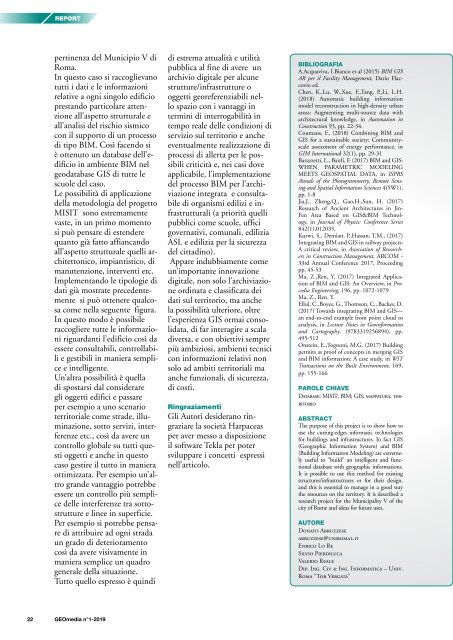GEOmedia_1_2019
You also want an ePaper? Increase the reach of your titles
YUMPU automatically turns print PDFs into web optimized ePapers that Google loves.
REPORT<br />
pertinenza del Municipio V di<br />
Roma.<br />
In questo caso si raccoglievano<br />
tutti i dati e le informazioni<br />
relative a ogni singolo edificio<br />
prestando particolare attenzione<br />
all’aspetto strutturale e<br />
all’analisi del rischio sismico<br />
con il supporto di un processo<br />
di tipo BIM. Così facendo si<br />
è ottenuto un database dell’edificio<br />
in ambiente BIM nel<br />
geodatabase GIS di tutte le<br />
scuole del caso.<br />
Le possibilità di applicazione<br />
della metodologia del progetto<br />
MISIT sono estremamente<br />
vaste, in un primo momento<br />
si può pensare di estendere<br />
quanto già fatto affiancando<br />
all’aspetto strutturale quelli architettonico,<br />
impiantistico, di<br />
manutenzione, interventi etc.<br />
Implementando le tipologie di<br />
dati già mostrate precedentemente<br />
si può ottenere qualcosa<br />
come nella seguente figura.<br />
In questo modo è possibile<br />
raccogliere tutte le informazioni<br />
riguardanti l’edificio così da<br />
essere consultabili, controllabili<br />
e gestibili in maniera semplice<br />
e intelligente.<br />
Un’altra possibilità è quella<br />
di spostarsi dal considerare<br />
gli oggetti edifici e passare<br />
per esempio a uno scenario<br />
territoriale come strade, illuminazione,<br />
sotto servizi, interferenze<br />
etc., così da avere un<br />
controllo globale su tutti questi<br />
oggetti e anche in questo<br />
caso gestire il tutto in maniera<br />
ottimizzata. Per esempio un’altro<br />
grande vantaggio potrebbe<br />
essere un controllo più semplice<br />
delle interferenze tra sottostrutture<br />
e linee in superficie.<br />
Per esempio si potrebbe pensare<br />
di attribuire ad ogni strada<br />
un grado di deterioramento<br />
così da avere visivamente in<br />
maniera semplice un quadro<br />
generale della situazione.<br />
Tutto quello espresso è quindi<br />
di estrema attualità e utilità<br />
pubblica al fine di avere un<br />
archivio digitale per alcune<br />
strutture/infrastrutture o<br />
oggetti georeferenziabili nello<br />
spazio con i vantaggi in<br />
termini di interrogabilità in<br />
tempo reale delle condizioni di<br />
servizio sul territorio e anche<br />
eventualmente realizzazione di<br />
processi di allerta per le possibili<br />
criticità e, nei casi dove<br />
applicabile, l’implementazione<br />
del processo BIM per l’archiviazione<br />
integrata e consultabile<br />
di organismi edilizi e infrastrutturali<br />
(a priorità quelli<br />
pubblici come scuole, uffici<br />
governativi, comunali, edilizia<br />
ASL e edilizia per la sicurezza<br />
del cittadino).<br />
Appare indubbiamente come<br />
un’importante innovazione<br />
digitale, non solo l’archiviazione<br />
ordinata e classificata dei<br />
dati sul territorio, ma anche<br />
la possibilità ulteriore, oltre<br />
l’esperienza GIS ormai consolidata,<br />
di far interagire a scala<br />
diversa, e con obiettivi sempre<br />
più ambiziosi, ambienti tecnici<br />
con informazioni relativi non<br />
solo ad ambiti territoriali ma<br />
anche funzionali, di sicurezza,<br />
di costi.<br />
Ringraziamenti<br />
Gli Autori desiderano ringraziare<br />
la società Harpaceas<br />
per aver messo a disposizione<br />
il software Tekla per poter<br />
sviluppare i concetti espressi<br />
nell’articolo.<br />
BIBLIOGRAFIA<br />
A.Acquaviva, I.Bianco et al (2015) BIM GIS<br />
AR per il Facility Management, Dario Flaccovio<br />
ed.<br />
Chen, K.,Lu, W.,Xue, F.,Tang, P.,Li, L.H.<br />
(2018) Automatic building information<br />
model reconstruction in high-density urban<br />
areas: Augmenting multi-source data with<br />
architectural knowledge, in Automation in<br />
Construction 93, pp. 22-34.<br />
Coumans, F., (2018) Combining BIM and<br />
GIS for a sustainable society: Communityscale<br />
assessment of energy performance, in<br />
GIM International 32(1), pp. 29-31<br />
Barazzetti, L., Banfi, F. (2017) BIM and GIS:<br />
WHEN PARAMETRIC MODELING<br />
MEETS GEOSPATIAL DATA, in ISPRS<br />
Annals of the Photogrammetry, Remote Sensing<br />
and Spatial Information Sciences 4(5W1),<br />
pp. 1-8<br />
Jia,J., Zheng,Q., Gao,H.,Sun, H. (2017)<br />
Research of Ancient Architectures in Jin-<br />
Fen Area Based on GIS&BIM Technology,<br />
in Journal of Physics: Conference Series<br />
842(1),012035,<br />
Kurwi, S., Demian, P.,Hassan, T.M., (2017)<br />
Integrating BIM and GIS in railway projects:<br />
A critical review, in Association of Researchers<br />
in Construction Management, ARCOM -<br />
33rd Annual Conference 2017, Proceeding<br />
pp. 45-53<br />
Ma, Z.,Ren, Y. (2017) Integrated Application<br />
of BIM and GIS: An Overview, in Procedia<br />
Engineering, 196, pp. 1072-1079<br />
Ma, Z., Ren, Y.<br />
Ellul, C.,Boyes, G., Thomson, C., Backes, D.<br />
(2017) Towards integrating BIM and GIS—<br />
an end-to-end example from point cloud to<br />
analysis, in Lecture Notes in Geoinformation<br />
and Cartography, (9783319256894), pp.<br />
495-512<br />
Onstein, E.,Tognoni, M.G. (2017) Building<br />
permits as proof of concepts in merging GIS<br />
and BIM information: A case study, in WIT<br />
Transactions on the Built Environment, 169,<br />
pp. 155-166<br />
PAROLE CHIAVE<br />
Database; MISIT; BIM; GIS; mappatura; territorio<br />
ABSTRACT<br />
The purpose of this project is to show how to<br />
use the cutting-edges informatic technologies<br />
for buildings and infrastructures. In fact GIS<br />
(Geographic Information System) and BIM<br />
(Building Information Modeling) are extremely<br />
useful to "build" an intelligent and functional<br />
database with geographic informations.<br />
It is possible to use this method for existing<br />
structures/infrastructures or for their design,<br />
and this is essential to manage in a good way<br />
the resources on the territory. It is described a<br />
research project for the Municipality V of the<br />
city of Rome and ideas for future uses.<br />
AUTORE<br />
Donato Abruzzese<br />
abruzzese@uniroma2.it<br />
Enrico Lo Re<br />
Silvio Pierdiluca<br />
Valerio Reale<br />
Dip. Ing. Civ & Ing. Informatica – Univ.<br />
Roma “Tor Vergata”<br />
22 <strong>GEOmedia</strong> n°1-<strong>2019</strong>


















